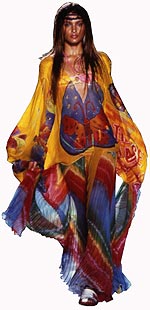
Couture Sutra
John Galliano, head designer at Christian Dior, has done quite a lot to change haute couture. Recent collections have been inspired by The Matrix and featured multi-thousand-dollar versions of big, fluorescent pants. There’s even been the odd codpiece involved. But in his most recent couture show, which the designer pronounced was “Barbie Goes to Tibet,” a passage of long, caftanlike dresses in butterfly and cartoon prints bore some naughty surprises on the backs: The cartoon figures (some looked like Pokémon characters, others were just grinning, seventies smiling faces) were graphically demonstrating what the House of Dior describes as “the various poses of the Kama Sutra.” “It was all very tie-dyed and handpainted,” said Mark Walsh, a designer and couture dealer who spotted the X-rated cartoons from his seat. “But if you looked closely, you saw things. Unmentionable things. Now I realize what those smiling faces are smiling about.”
Pearl River
Whatever you do, don’t credit this season’s revival of costume pearls to a recent wave of Bushism – they’re pure Coco Chanel. “Her first pearls were a simple strand around her neck, back in 1924,” says Caroline Rennolds Milbank, a fashion historian who’s working on a book about couture accessories. “It was the first time a designer had shown costume jewelry, and they really took off.” And while they disappear from time to time, they seem to always make a return. Big pearls are all over this season’s Chanel (there were even pearl toe rings in the couture show), and countless imitators (R. J. Graziano, for example) have tried their hand at the dress-up perennial. They go nicely with Miguel Adrover’s neo-prep, with Marc Jacobs’s thirties girl, and with fall’s other revival, the Little Black Dress. “Not only are pearls classic,” Milbank says, “but knocking them off is classic, too.”
Village Scout
One thing the Supreme Court has no jurisdiction over – thank God – is what you wear. This summer, Henri Bendel is carrying blouses by an L.A. company called Industry Rag that look nearly identical to Boy Scout uniforms, but with cap sleeves and a slim, narrow fit. “We made one with long sleeves for Usher,” says Edward Bromberg, who designed the shirt. “But they were originally made for women.” They have been selling out – to gay men. Which, for Bromberg, explains a lot. “We’d been wondering why all the shops were reordering the larges.” The shirts come in tan and navy (no neckerchiefs, though) and are covered in patches – bobcats, eagles, American flags – plus a tiny chain on which to hook your penknife. There’s also a little studding, which, last time we checked, was not in the Boy Scout handbook.
Smart Set
Sameer Reddy
Not many people leave college with a terribly clear idea of what they’d like to do, aside from trading in their futons for real mattresses. But in the year since Sameer Reddy graduated from Bard, he has started a media and design consultancy, designed a sushi restaurant-nightclub that will open in Detroit this fall, and amassed a collection of vintage couture that has caught the attention of the city’s savviest fashion-philes. “I’m obsessive,” he says with a shrug, sorting through a rack in his Chelsea apartment. “I shop every day.” The result is a meticulously organized tour of fashion from the thirties through the eighties, with perfectly maintained pieces by each era’s most important designers (Chanel, Kenzo, YSL, Alaïa). Reddy plans on dealing to private clients and will debut his findings at a trunk show at the Time Hotel on August 8. “Recycling fashion concepts is both practical and beautiful,” Reddy says. “That’s why I think all this interest in vintage is entirely modern.”